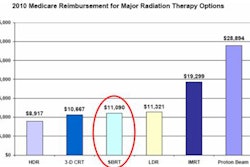The best treatment for patients older than 75 who are diagnosed with localized renal cell carcinoma may be active surveillance, according to recommendations from urologists at the Cleveland Clinic. Not only do these patients have a higher risk of death from heart failure, but treatment may contribute to renal function loss, leading to chronic kidney disease.
Though it is unlikely that a clinical trial will ever be conducted to determine if active surveillance is better for elderly patients than aggressive management, physicians at the Cleveland Clinic's Glickman Urological and Kidney Institute retrospectively reviewed the medical records of 537 patients to determine if surgical intervention, including radiofrequency ablation, improved survival. Their findings were reported in the July 1 issue of Cancer (2010, Vol. 116:13, pp. 3119-3126).
The patients, ages 76 to 86, were treated between January 2000 and December 2006 and had suspected clinical stage T1 renal cancer when initially evaluated. Of the group, 27% had a nephrectomy and 53% had nephron-sparing interventions. Active surveillance was selected for 20%, and these patients were followed clinically every six months with renal imaging.
Median follow-up was almost four years. Thirty-four patients (6.3%) of the total had their cancer recur, and 148 patients (28%) died. Cardiovascular events were attributed to 29% of patient deaths. Only 4% of the patients died from kidney cancer progression -- of these 22 patients, 11 had originally been diagnosed with advanced renal cancer and 10 had originally been diagnosed with upper-tract urothelial carcinoma.
Five years following treatment, the cumulative incidence of cancer-specific mortality was 5.8% for patients under active surveillance, compared with 9.3% for patients who had nephrectomies and 4% for patients who had nephron-sparing intervention. But interventions for clinical T1 renal cancers were not associated with an improvement in overall survival, lead author Brian Lane MD, PhD, and colleagues reported.
In fact, having a radical nephrectomy may have made the overall health of an elderly patient worse. Although 39% of the patients had pre-existing chronic kidney disease before surgery, the percentage of patients with renal dysfunction rose to 86% after surgery. And decreased kidney function increased the risk of cardiovascular death.
"Any potential oncologic benefit from radical nephrectomy probably was overshadowed by the cost of this approach in terms of renal function and cardiovascular morbidity," the authors wrote.
Only 12% of tumors treated with nephron-sparing intervention and 40% of those removed by nephrectomy had potentially aggressive pathologic features, the authors pointed out. With an aging baby boomer generation, as well as the ability of today's abdominal imaging modalities to provide superior images that have increased incidental detection of small renal tumors, the incidence of renal cell carcinoma has increased approximately 2.3% per year over the past 10 years.
The authors advise aggressive management if the cancer is likely to reduce an individual's life expectancy; however, they strongly recommend that management of clinically localized, suspected renal cell carcinoma be individualized based on predicted life expectancy. This should include active surveillance, a responsible strategy that is greatly underused in the elderly population, according to the researchers.
By Cynthia E. Keen
AuntMinnie.com staff writer
July 9, 2010
Related Reading
RFA destroys small renal masses, July 2, 2010
Screening VC sorts out incidental kidney lesions, June 15, 2010
Cryoablation highly effective for localized kidney cancer, March 11, 2009
Copyright © 2010 AuntMinnie.com



















